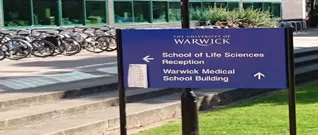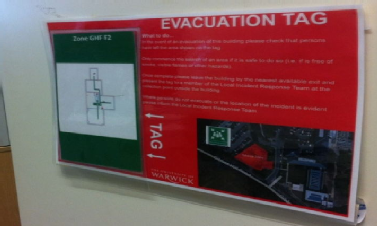Gibbet Hill Campus
The School of Life Sciences and Warwick Medical School at Gibbet Hill campus operate a sweep and tag system for building evacuation. All staff and PhD students must complete the Sweep and Tag MoodleLink opens in a new window and Fire SafetyLink opens in a new window training as part of their induction process. This training explains how the system works and their role and responsibilities during an emergency evacuation.

The buildings which use this system are:
|
· Mechanochemical Cell Biology Building (MCBB) |
· Clinical Trials Unit (CTU) |
· Medical Teaching Centre (MTC) |
|
· Gibbet Hill Academic Building (A, B, C Block) |
· Biomedical Research Building (BMRI) (M, C Block) |
· Biotechnology (D Block) |
|
· MRC Laboratory (Novo/MRC lab) |
· Teaching (E Block) |
· Biotechnology Phase 4 (BSU) |
|
· The Elizabeth Creak Horticultural Technology Centre (ECHTC; Transgenic Plant Lab) |
· CL3 Facility |
· Interdisciplinary Biomedical Research Building (IBRB) |
In summary:
Staff and PhD students
In the event of the fire alarm sounding, any member of staff or PhD student can take an evacuation tag and sweep the zone identified on it (the rooms are marked on the back of the tag); if it is safe to do so.
On exiting the building, take the tag and provide information to the Local Incident Response Team (LIRT) at the assembly point (all wearing a hi-vis red/blue vest).
The LIRT member will place the tag green side forward on the tag collection boards located at the assembly point, if the designated rooms have been checked as clear. If all the zones marked on the tag have not been swept, the tag will be placed orange side forward on the tag collection board.
The tag collection board will be overseen by a LIRT member which supports the management of an incident once staff and students have left the buildings.
Visitors
Staff and PhD students who are hosting visitors to their group must:
- Ensure that all visitors have been informed of the emergency evacuation procedures on their first day including been shown refuge points; if applicable and the assembly point
- Ensure that all visitors are escorted to the assembly point on hearing the alarm
- Ensure all visitors remain at the assembly point until you, the host, have been told it is safe to re-enter the premises
All other persons
Follow the basic fire response proceduresLink opens in a new window.

